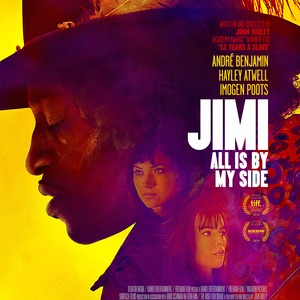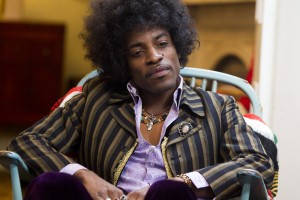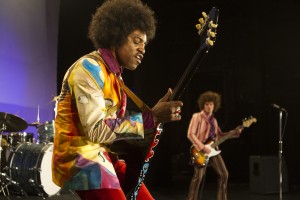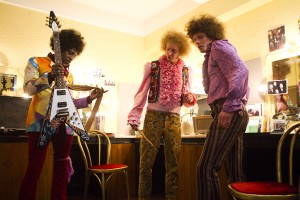 Venues: AMC Empire (234 42nd Street, NY 10002) & Landmark Sunshine (143 E Houston Street, NY 10002)
Venues: AMC Empire (234 42nd Street, NY 10002) & Landmark Sunshine (143 E Houston Street, NY 10002)
Date: September 26, 2014
Ticket Phones: AMC Empire: 212-398-2597 & Landmark Sunshine: 212-260-7289
When filmgoers watch JIMI: All is By My Side, which opens on September 26 in 16 American cities, they will explore musical and narrative nuances rarely discussed in conversations about Jimi Hendrix’s career. The film, which stars André Benjamin (Outkast) and Imogen Poots (28 Weeks Later), was written by Oscar-winner and directed by John Ridley (12 Years a Slave). Ridley tapped Grammy-award-winning music producer Danny Bramson (Almost Famous, Lord of the Rings) as producer and music designer and the two of them fastidiously interpreted the soundscape of the era in a way that will tickle music buffs of the period.
“The film takes place in that lost or underserved year in Jimi’s life,” explains Bramson. “We were well aware of the Hendrix Estate’s long standing reluctance to allow any of Jimi’s original songs for an unauthorized Hendrix themed film. Thus, we never sought out Jimi’s hits that came once he departed Heathrow for the Monterey Pop Festival. The musically fertile environment of John Ridley’s story allowed me to interpret Jimi’s development from playing second lead guitar with Curtis Knight in New York then forming his first group and gigging afternoon performances at the Café Wha?, onto his arrival in London at the height of it’s musical enthrallment with the indigenous American Blues. With the Hendrix standard songs out of the equation, we chose a musical design as an interpretation of Jimi’s development as a guitarist principally, and the English musical and cultural zeitgeist that informed, inspired, and propelled him. The creative challenge was staggering, underscored with the incessant personal responsibility to get it right.”
For most, Hendrix’s name conjures up songs like “Purple Haze” or “Foxy Lady,” or possibly scenes of Jimi’s breakthrough at 1967’s Monterey International Pop Festival evocatively humping the amps and lighting his guitar on fire. But JIMI: All is By My Side sets the stage for all of that and the film wraps up before the Summer of Love even starts. In the end, Ridley and Bramson constructed never-before-seen glances, pivotal moments in Hendrix’s early career giving insights into where he came from before his musical identity was sealed, before stereotypes were reified in the global consciousness.
When Linda Keith, Keith Richards’ girlfriend played by Imogen Poots, scoops up Hendrix, who was scraping by as the second guitarist in Curtis Knight and the Squires in Greenwich Village, he thumbs through her vinyl collection, and the film sheds a gentle light on the influence of pivotal musicians of the time. “This is where we went with an inspired psychedelic run, from Bob Dylan’s ‘Leopard Skin Pillbox Hat,’ to the American blues of Buddy Guy, injected with shades of Mozart and T-Bone Walker,” says Bramson, who was already well-known for being at the forefront of the film and music world. He’s collaborated with the likes of Dylan, McCartney, and for being the first to license for film rock stars like Neil Young and Radiohead, while working with directors Cameron Crowe, Paul Thomas Anderson, and Peter Jackson. “There was no need to zero in on the hits and their iconography,” continues Bramson. “We wanted nuanced music to complement these nuanced moments that John Ridley’s directing captured so elegantly and seductively.”
Similarly, in one of Bramson’s favorite scenes, the Small Faces’ song “Itchycoo Park” accompanies Hendrix and his girlfriend Kathy Etchingham, played by Hayley Atwell, as they strolled through the boutiques of Carnaby Street, a 1960’s hub for Swinging London, and a place where the Beatles, Smalls Faces, the Rolling Stones, Cream, and The Who gathered. “I find the poetry in these stolen moments to exemplify the very best of the film,” says Bramson. “Whether it’s a simple exchange of glances, a smile, or a young Jimi Hendrix sitting on the edge of a bed working out a guitar line.”
To assist with securing the plethora of musical choices, Bramson tapped music supervisor Chris Mollere. “I knew I made the big time after some forty odd films when I had the luxury of my very own music supervisor, and such a good and proficient one in Chris!” exclaims Bramson.
But those subtle musical selections are the tip of the iceberg for the film’s music design. At a recent festival showing of the film, excited moviegoers walked Bramson back to his hotel, exclaiming how brilliant André Benjamin’s guitar performances were. “That was the greatest complement we could’ve received and I giggled with delight and a bit of relief,” says Bramson. Though Benjamin was already a good right-handed guitar player, Bramson hand-picked instructor Andrew Rollins, who established a daily regimen of six hour rehearsals for months leading into and during the film’s entire production to make him look effortless and fluid as a lefty. “André’s relentless dedication to get it right didn’t let up until we wrapped,” says Bramson.
Technical authenticity was critical in all of the performance moments in the film. This attention to detail allows the audience to lose themselves, and take the ride. “We weren’t going to use a crowded room or a reversed camera to camouflage André’s fingers,” says Bramson. “With that dare, asking André to try to approximate Hendrix would have been daunting even if he had been an exceptional left-handed guitar player. But André readily accepted the challenge and diligently worked with Rollins in capturing the fingering of what we fed him. John and I broke down our songs and performances and had them focus on specific sections, six bars here, twenty seconds there, and after months of relentless and repetitive rehearsals, André gave us breathtaking and thoroughly convincing takes on camera and his dedication and embrace of his guitar is as heartfelt a performance as I’ve ever witnessed from an actor and artist.”
For the film’s original music, Bramson brought in long-time friend and collaborator, Waddy Wachtel, legendary, in-demand session guitarist, who plays for Linda Ronstadt, Stevie Nicks, and Keith Richards, among others, and most recently was seen as musical director leading the revolving “house-band” on the 2014 Rock and Roll Hall of Fame Induction special on HBO. Ironically, Wachtel’s early childhood guitar teacher started him playing right-handed even though he was naturally left-handed. “From the moment I read the script, I had my eye on Waddy,” says Bramson. “I knew I didn’t want to cast a star-driven guitarist, because I needed not only talent and dexterity, but someone who could sublimate their ego and signature licks. Waddy brought the all-important X factor of malleability and patience, working and flushing out the material sitting there, knee-to-knee, as we did for months on end until we found what we were going for. I was merely the obsessive spark and amateur musicologist, with Waddy’s talent and hands providing the genius behind every note of the material and performances. My joke since then has been ‘Music by Wachtel, Lyrics by Bramson,’ but they’re all instrumentals!” laughs Bramson. To replicate the Hendrix trio, Wachtel was joined by Kenny Aronoff on drums and session legend Lee Sklar on bass. Legendary engineer Niko Bolas (Neil Young) was given the task of reproducing the analog ambience of the era’s music.
The combination of the expect-the-unexpected approach with Wachtel’s and Bramson’s era-evocative delivery culminates to re-create an under-celebrated moment in Hendrix’s career. On June 4, 1967, right before Jimi Hendrix and the Experience were set to get on stage at London’s Saville Theater, a mere two weeks before Monterey, Hendrix dashes into the dressing room with a record released only three days earlier: The Beatles’ Sgt. Pepper Lonely Heart’s Club Band. The trio quickly rehearses the title song, knowing that Paul McCartney and George Harrison are there in the audience.
As another shining example of the films’ credibility and its attention to detail, the film climaxes with this performance by Hendrix and the Experience. The Beatles allowed the song to be licensed for use in the film (an extremely rare occurrence), thanks to Bramson, who has a longstanding history of working McCartney compositions into film (Jerry Maguire, Vanilla Sky). And for the first time ever, music fans not in that room in 1967 see what it would be like to hear Jimi Hendrix play that song in that pivotal moment, where Hendrix came into his own, as a visitor among the British Invasion, before returning to America and plunging into the Jimi Hendrix everyone now knows and loves.
The extreme dedication of Benjamin to become Hendrix, the sultry and irresistible deliveries from Imogen Poots and Hayley Atwell, the depth and subtleties of Ridley’s writing and direction, and the scrupulous integrity of Bramson and Wachtel to get the music right, leave their mark with a musical biopic created for everyone from cursory music fans to dedicated Hendrix aficionados looking to experience the magical cultural period and musical atmosphere. Music “purists” will appreciate that the filmmakers took the care to properly curate the licensed tracks for the period, but will be truly blown-away by the quality and energy of the newly recorded score and tracks in the film.
Related Posts
Some Thoughts About a guitar legend: Tell the Children that Jimi Hendrix Once Walked the Earth!




